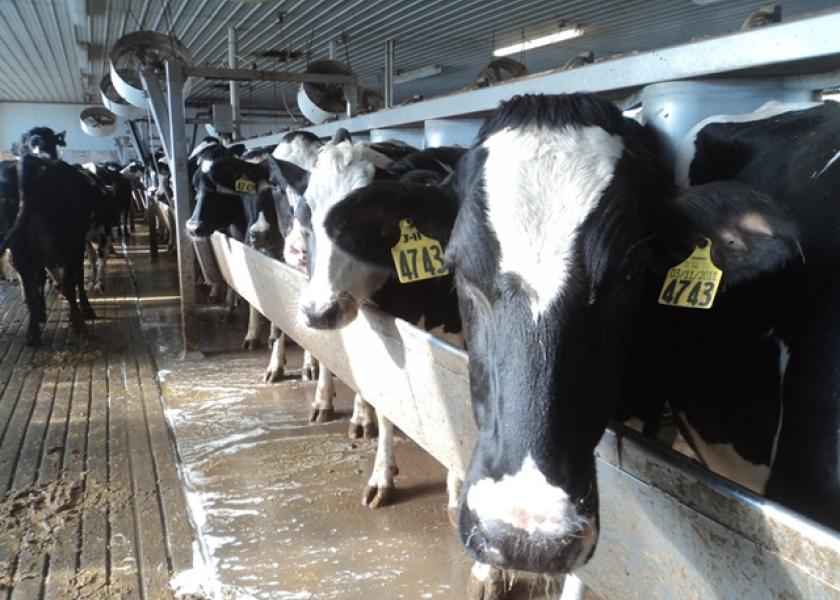Wisconsin Dairy Farmers Feeling the Pinch of Low Milk Prices

With milk prices down a third from a five-year high in September, Wisconsin dairy farmers are feeling the pinch in their pocketbooks.
"The bottom line is its 30 percent off the top," Mindoro dairy farmer Paul Larson said. "None of the expenses have changed, so it hurts."
According to USDA data, milk prices in March hit a low of $17.10 per hundredweight in Minnesota and $17.60 in Wisconsin. Milk prices topped out at a five-year high in September of last year, with Minnesota seeing $27.10 per hundredweight and Wisconsin farmers $26.60, the La Crosse Tribune reported.
Since March, milk prices have come back up slightly, but were still hovering under the $18 mark in both states in June, the last month data was available. For farmers, this means the milk price has fallen 33 percent in less than a year, a big shock for farmers to absorb.
"The money doesn't go as far as it did before," Winona County Farm Bureau president and dairy farmer Glen Groth said. "We're obligated to take care of the animals and pay the bills. Those costs don't go away."
The financial situation for each farm in the region depends on the farmer, Groth said. He hoped many of them had used the good times to pay down debt and save for today's lean times.
Most farms are probably breaking even, he said, but there will be some losers as well. It's the nature of the dairy industry.
"Down prices lead to high prices and high prices lead to down prices," Groth said.
Things aren't as bad as they could be. Groth said the milk price was even lower in 2010, when it reached $14.60 that March. And in 2012, milk prices hit a similar $17 low at the same time corn prices were beginning their historic rise toward $7 a bushel and a drought took its toll on alfalfa.
Corn and feed prices have come down since then, providing some relief. But costs for other inputs such as fuel, fertilizer and electricity haven't. And Groth said while prices have stabilized, he wasn't sure which way the market will go.
One of the factors in the recent low prices is the exports market, which is new territory for the U.S. dairy industry. In the past, the U.S. exported only a little of its milk supply, Groth said. Today, the country ships 15 percent of milk production overseas.
Demand for milk products has dried up in Russia due to economic sanctions. China was another big customer but is now experiencing a glut. And New Zealand is a big milk exporter, providing competition on the market.
Monroe County University of Wisconsin Extension agriculture agent Bill Halfman said the export market could go either way in the near future. The domestic supply is also higher than demand, applying additional downward price pressure. And a third factor, the Dairy Margin Protection Program that came out of the 2014 Farm Bill, could also provide some relief to farmers.
The program, administered through the USDA, provides payments to participating farmers when the milk price is less than $4 per hundredweight more than average feed costs. Producers may also purchase buy-up coverage that provides payments when margins are between $4 and $8. Sign-up for the 2016 program continues into September.
"It provides a level of cushion for situations like this," Halfman said.
The organic dairy industry is facing its own struggles, said for Cooperative Regions of Organic Producer Pools vice president for sales Eric Newman. Organic Valley is one of the CROPP Cooperative brands, and Newman said organic prices have increased $5 per hundredweight over the past two years, reaching a $36 per hundredweight average.
The market for organic dairy products is growing faster than the supply, he said, resulting in the price increases. But input costs for farmers remains high, cutting into farmer's profits.
It takes several years for a farm to convert to organic, making it challenging to quickly increase supply. And organic feed costs are high, which affects not only current organic producers but also transitioning farms that are required to use organic feed for at least a year before they can market their milk as organic.
Newman said CROPP works with the cooperative's member owners to keep things stable, providing assistance to new members during the transition or other emergencies such as droughts. But that doesn't mean things are easy for organic producers, who are struggling to turn a profit, just like their conventional counterparts.
"It's a difficult time for everyone in the dairy industry," Newman said.







